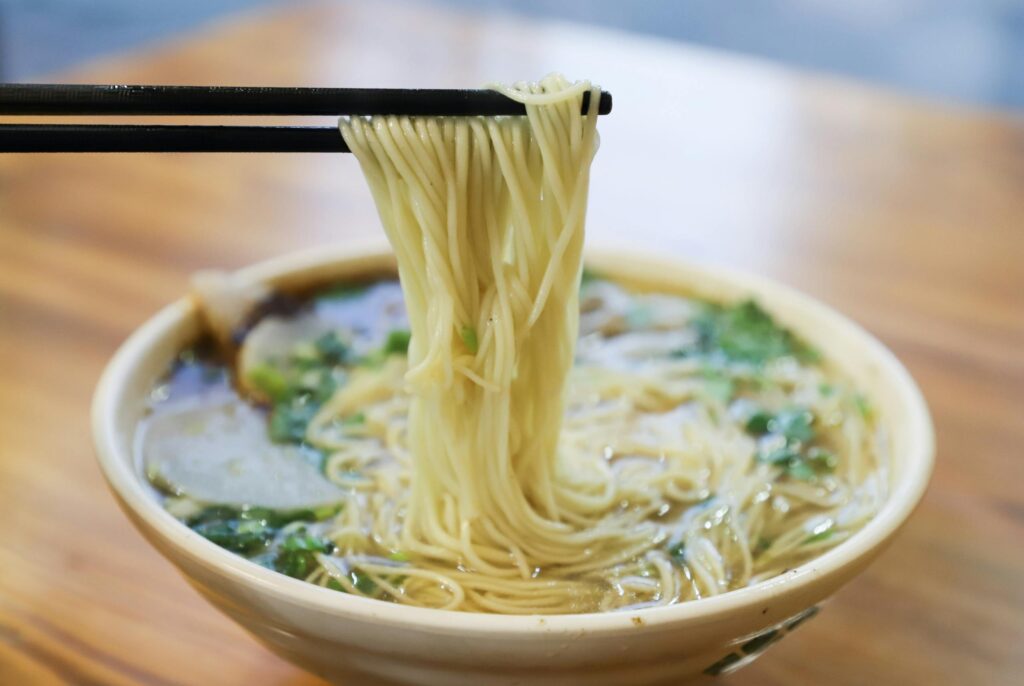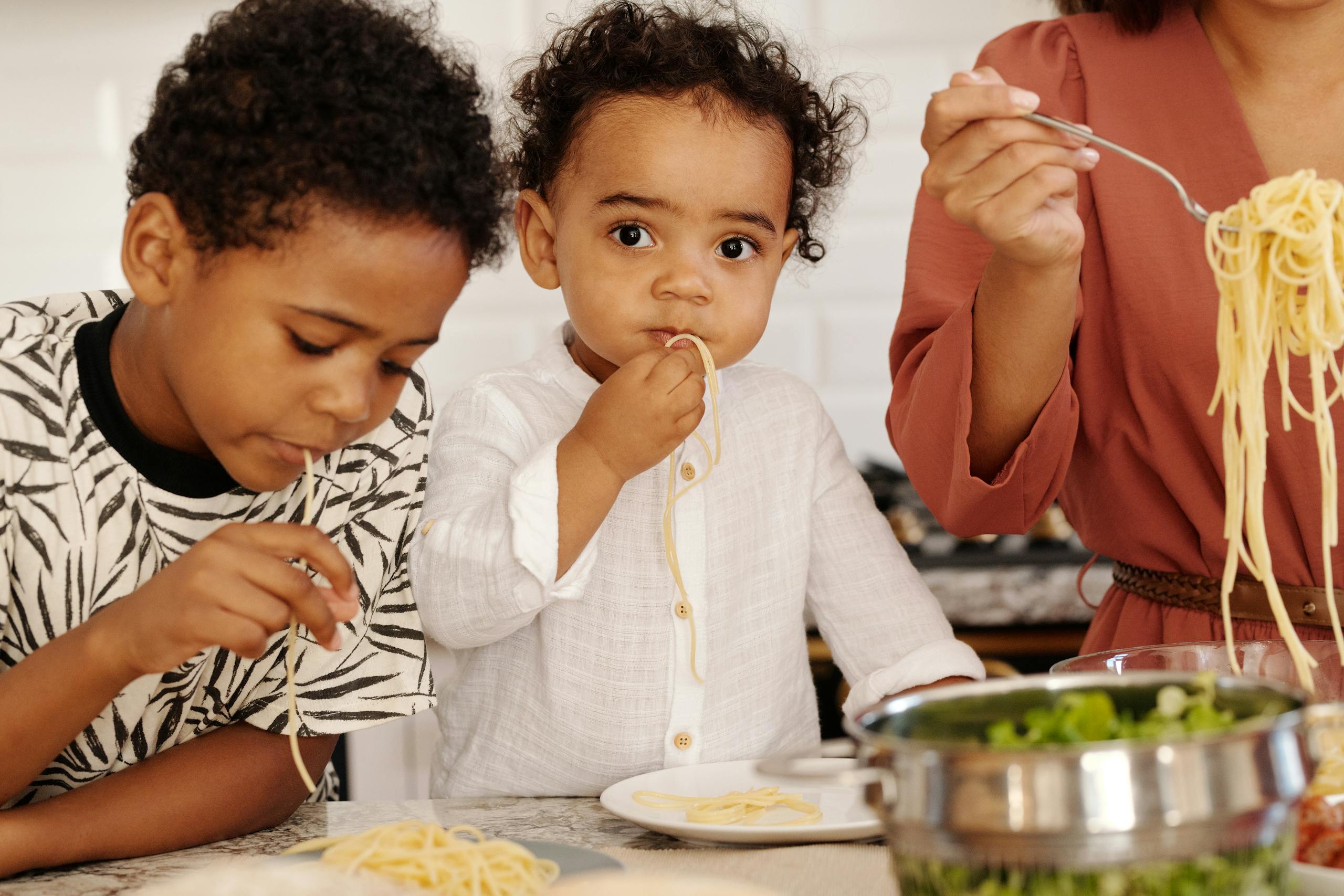10 Ways to Make Mealtime Fun With Your Toddler
Mealtime is rarely a breeze, even if your toddler is considered a “good eater.” Between spilled water, thrown food, tantrums, and picky eating, many parents just stick to foods they know are “safe” to keep their child happy. We’ve all been there, and it can feel so defeating when you make a new meal only for your child to refuse to touch it. If this sounds like you, you’re in luck. I’ve got 10 tips to make mealtime more fun with your toddler.
1. Try Out New Utensils
What utensils do you use with most meals? In most places, forks, spoons, and knives are the norm. This makes sense since they are practical and allow people to eat efficiently. But they aren’t very exciting to young minds who, on occasion, like to switch things up.
For Mother’s Day this year, my mom and I went out to an asian restaurant and took my daughter Em along. Naturally, they provided chopsticks along with the standard cutlery. As we chowed down on our sushi, my toddler was mesmerized. She asked to eat using the “sticks” and gobbled up so much food without complaint because of the fun method of eating. Chopsticks are a bit tricky for kids, but they do have helper chopstick gadgets to make them more kid-friendly. A month later, she was eating chicken with her toddler-friendly chopsticks like a professional!
Besides chopsticks, you can change out their eating utensils with items you already have stocked in your kitchen drawers. Try things like spatulas, ladles, or even tongs. Keep in mind that depending on the material, you may need to provide additional assistance. Metal utensils are likely sharper than plastic, silicone, or wood and should be used with care.
These methods might be messier, but they are also fun and create a positive association with eating. This technique can be especially useful if you want to sneak in a few new food types since the focus is primarily on the serving method rather than the food.

2. Introduce Themed Meals
Themed meals are fun for both kids and adults. With themes, you can let your imagination run wild. Classics like Taco Tuesday or Meatless Monday can be an easy place to start.
Alternatively, you could do color themes! For example, you could have today’s snacks all be red and choose items like strawberries, raspberries, and tomatoes. If your child is used to prepackaged snacks, you can use this same technique or mix and match.
Themes can also be linked to popular books or shows. Green eggs and ham might not sound appealing, but with the help of food coloring, you can turn any normal food fun colors! Please look for food dyes made from natural substances rather than artificial colors to limit your child’s exposure to toxins.
3. Change Where You Eat
Routines are undoubtedly important for young children, but that doesn’t mean breaks from routine are always bad. Whether you eat at the table or in the living room, try switching it up by trying a new location.
If you’re concerned about introducing bad habits within the home (like you don’t want a child who thinks eating on the floor is normal), then take mealtime outside of the house.
Having a picnic outside allows for a change of scenery and can be a fun opportunity to burn off energy. The entire family can get involved with filling the picnic basket and choosing picnic-friendly snacks from the fridge. It’ll be easy to have your busy toddler graze on food as they alternate between running around and sitting down on the blanket.

4. Get Children Involved In the Meal-Making Process
My daughter shows a lot of interest in cooking. Sometimes it feels like a huge hassle to involve her. If she cracks eggs, I’ll have to pick out the shells, if she mixes then there’s likely to be a bigger mess, and so on. But even when it’s inconvenient, I try to include her. Acknowledging that it’s difficult but choosing to do it anyway is a core part of parenting. I know these situations are shaping her and building her confidence. I am teaching her real-life skills and growing her curiosity about food.
Naturally, you’ll need to choose age-appropriate tasks and monitor your child to keep them safe. Also, you’ll need to follow your toddler’s cues. If they’re happily engaged in another activity, you might want to skip involving them in that cooking session, or keep their task small. Similarly, if your child has been helping but lost interest, I’ve found it’s better to let them off the hook than force them to continue. If you can redirect, terrific, but if not, it’s better to help them find another activity than try and handle a tantrum while cooking.
I’ve found that asking questions about food, or even saying “wow, doesn’t that look yummy,” helps them to better engage in the experience. After involving Em in cooking, she is always more interested in tasting the meal than when I simply set a plate in front of her to eat.
5. Present the Dish in a New Way
Similar to the tip regarding serving utensils, you can also change how the meal is presented. Instead of the standard bowl or plate, you can try a fun swap. Large fruit or veggie tray holders can offer a unique presentation opportunity at snack time.
Some kids are very attached to certain bowls, cups, and containers, so if that sounds like your toddler, this method may have to be done on a larger scale. For example, you could choose a meal where you forego plates entirely. On social media, many parents are thinking outside the box and using everything from baskets, boxes, and parchment paper to change up the mealtime experience.
This technique can be as basic or as complicated as you’d like to make it. But keep in mind that the more you cater it to your toddler’s interests, the more successful it’ll likely be.
6. Offer Choices and Give Up Some Control
Too much choice can lead to overload, but some choice lets your kiddo feel in control. At my house, I like to hold up two options and let my toddler choose between them.
Would you like carrots or broccoli with dinner? Would you like pasta or rice today?
You might not be able to do it every day, but being involved in the decision-making process may help your toddler be less argumentative at dinner time.
Granted, your child may respond with pizza and ice cream no matter what you offer them, so some days are better than others.
As a busy mom, I recognize that giving your kids a choice in the decision-making process may not always be possible. If you have an independent toddler who loves making decisions, you can also reframe the situation by asking about the meal itself. For example, would you like a bite of chicken first or a bite of peas?

7. Rebrand Classic Meals
When you shop in the grocery store, marketing and branding tactics are plastered all over packages. Cereal boxes have popular cartoons or famous celebrities on the front, and chips and cookies are often clad in brightly colored packages. These techniques are used because they catch the shopper’s attention and entice them to buy.
As a parent, you can use these same style techniques to entice your toddlers to reimagine dishes.
There are two easy techniques you can use with this method. The first is buying a set of stickers with their favorite characters or hobbies. Take the stickers and apply them to the outside of food packages throughout the house. If your kiddo loves Bluey, slap on a sticker and suddenly your loaf of bread becomes Bluey bread!
The second technique involves your own creativity and ability to make connections, no stickers required. An example would be saying, “today we are eating Scooby Doo sandwiches” or “here’s a serving of Bugs Bunny carrots”. These references should relate to those shows or objects your toddler is most interested in.
8. Engage Your Toddler’s Senses
Encouraging your toddler to engage with all of their senses can make mealtime more exciting.
The five senses are taste, touch, sight, smell, and hearing. If you think about it, you use every sense when you eat. The taste sense is obvious, helping you to discover the flavors of the meal. But you are constantly using your other senses too. You use sight as you view the dish, taking in all of the colors and details. You use smell as the aromas reach your nose. As you eat, you use your sense of touch to distinguish various textures. Lastly, you hear the crispy crunch of something fried as you take a bite.
If you ask questions while they eat, it can help build their curiosity.
Example questions include:
- What color is that?
- Is that hard or soft?
- What does it smell like?
This line of questioning may also inspire your kiddo to begin asking their own questions!
9. Model New Foods
Young children are very observant. They look to their parents for cues on how to act. Consider the types of food your toddler watches you eat daily. Do you eat a wide variety of foods or only a few types on repeat? Similarly, do you eat whole foods or processed foods?
If you make a point of modeling the behavior you’d like to see, you may be surprised by the results. For instance, I was eating raw baby carrots and hummus, and my daughter asked to try some. I thought she wouldn’t like it, but sure enough, she went back for seconds!
I swear there’s a magic switch in their brain that says, “Wow, if mom or dad is eating it, it must be tasty!”

10. Follow Your Toddler’s Cues and Don’t Force Food
Ultimately, the happiest kids are the ones who feel heard and respected. Boundaries are important and should be recognized. You don’t want to raise mini dictators who believe it’s their way or the highway, but it’s also important not to crush their voice and free will. The key is finding a balance.
Asking them to try a bite or two of a food is reasonable. Forcing them, as they repeatedly express being done is unreasonable. Working on clear communication and offering a “done” bowl are two easy ways to recognize your toddler’s cues.
Make Mealtime Fun Again for Everyone
At the end of the day, every parent knows there will be smooth meals and chaotic meals. Remember to breathe through the madness and know that it can take many attempts before a child accepts a new food. Preferences often change with time, and you may be surprised by the transformation you see in just a matter of months. I hope this helps a parent in need!
Feel free to share your tried and true tips in the comments below!






